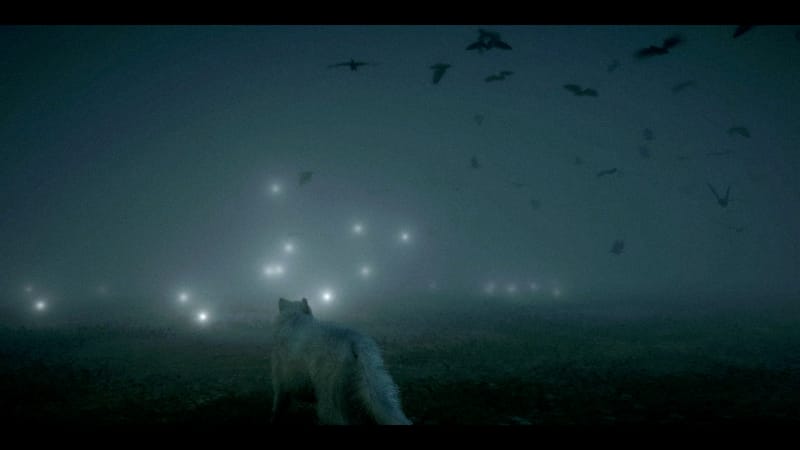Most games traffic in metaphor. They ask you to slay dragons when you're really conquering your fears, and build civilizations when you're actually learning management skills.
Risa Puno strips all that away. Her installations confront players with the raw material of human emotion—disagreement, frustration, rage, care—using the familiar grammar of mini golf and party games to create spaces for processing feelings we'd rather avoid. A cooperative maze becomes a relationship stress test. A par-infinity putting green forces you to sit with your own impatience. There's no fantasy buffer, no narrative distance. Just you, the game, and whatever you're carrying into it.
Puno's solo show, Group Hug, emerged from her family's medical crisis and centers on kapwa, a Filipino concept of shared humanity that demands reciprocal care. It's game design as community healing, play as mutual aid. Here, we speak with Puno about emotional honesty in interactive spaces, why simplicity cuts deeper than complexity, and the power of games to hold us when we're falling apart.
Jamin Warren: Could you tell us a little bit about your background? We sometimes make these distinctions between left-brain and right-brain people. I understand you've managed those two things well, dating back to your third-grade science project. Would you share with them?
Risa Puno: Yeah, I grew up in Louisville, Kentucky. My parents emigrated from the Philippines, and that's me. I'm a child of the '80s. I didn't grow up with an art background—my background was that I was really into math and science growing up.
I was a creative kid, and for me, creativity comes into play whether you're into art, whether you're into math, or science. Those things go hand in hand, but I was encouraged to pursue math and science growing up, and I didn't even take art in high school. I went to Brown, and I was in their eight-year medical program at Brown University, but since I was already in med school, they encouraged us to be well-rounded. And so I thought, cool, I can take art because I've always wanted to try it. I declared myself an art major because it was easier to get into art classes. And then I was like, oops, I kind of love this. And I had a super awkward conversation with Dr. Mom and Dr. Dad. So here I am, taking some of my first art classes and falling in love.
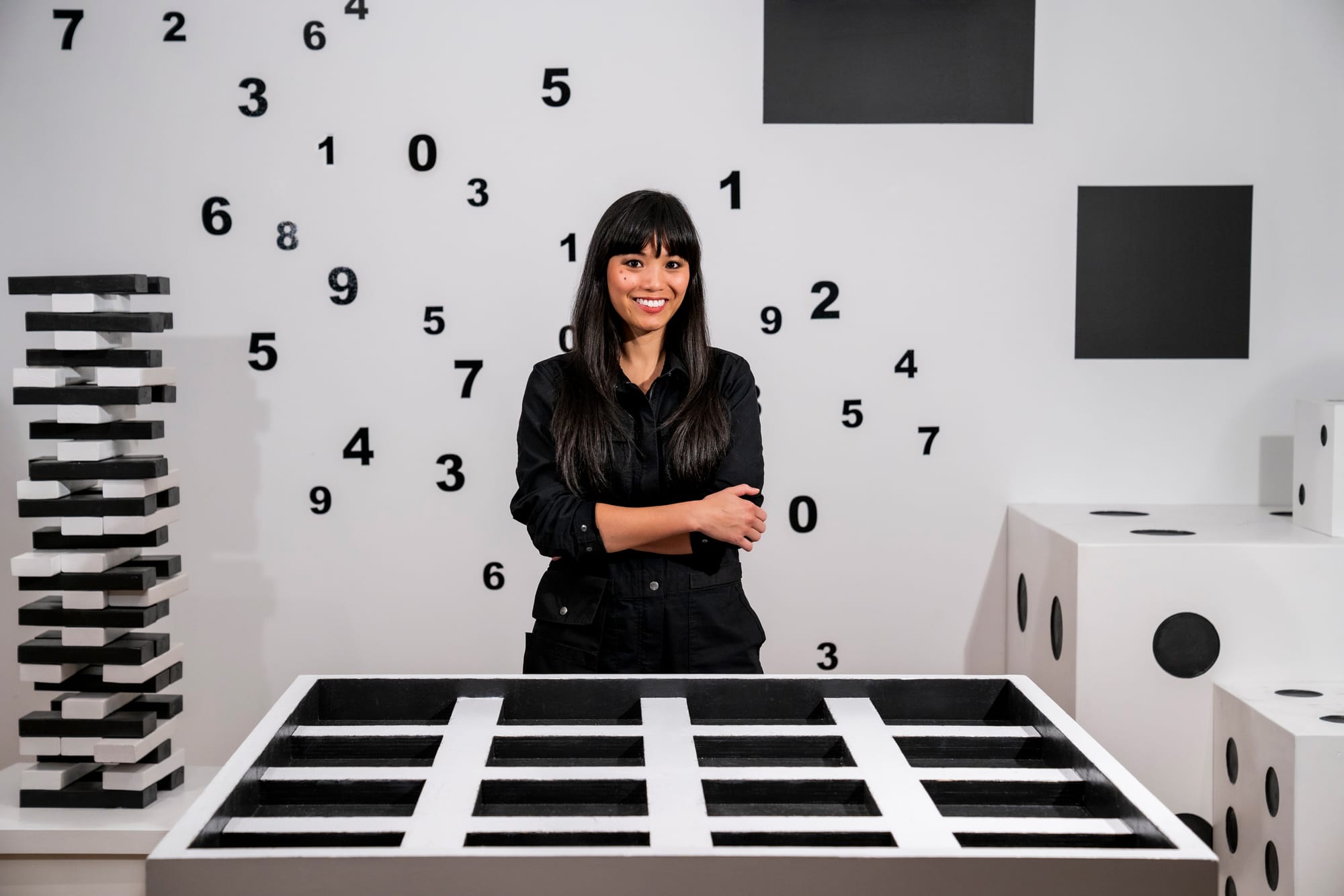
Jamin Warren: So from there, in terms of some of those early—were there expressions from your early art school classes that you find kind of like through your work today? What were some of the questions you were being encouraged to ask as an art student, and maybe, how did it connect to some of the questions you were being asked as someone interested in the sciences as well?
Risa Puno: Oh, my god. Honestly, I was not asking real questions to tell you the truth. I was just excited to be learning the processes, using my hands. I didn't have a real portfolio; it was more about exploring materials. And since I didn't come from an art background, it was always important—I always wanted to connect with people. I've always wanted to connect with people through my art, and I always wanted to share it with my family and friends, who—I don't have any artists in my family, and a lot of my friends weren't in the art program.
And so I always wanted to have points of access in my art. I didn't want people to have to understand the canon of fine art history to be able to connect with my work. And so I think that's always why I've had references to familiar objects or things like games in my work, but I think at first I wasn't investigating big questions. It was more about sort of—I've always approached it from more of a personal place.
Jamin Warren: You mentioned materials. Certainly, the materiality for your work has been a through line—your work is very non-digital.
Risa Puno: I do love objects.
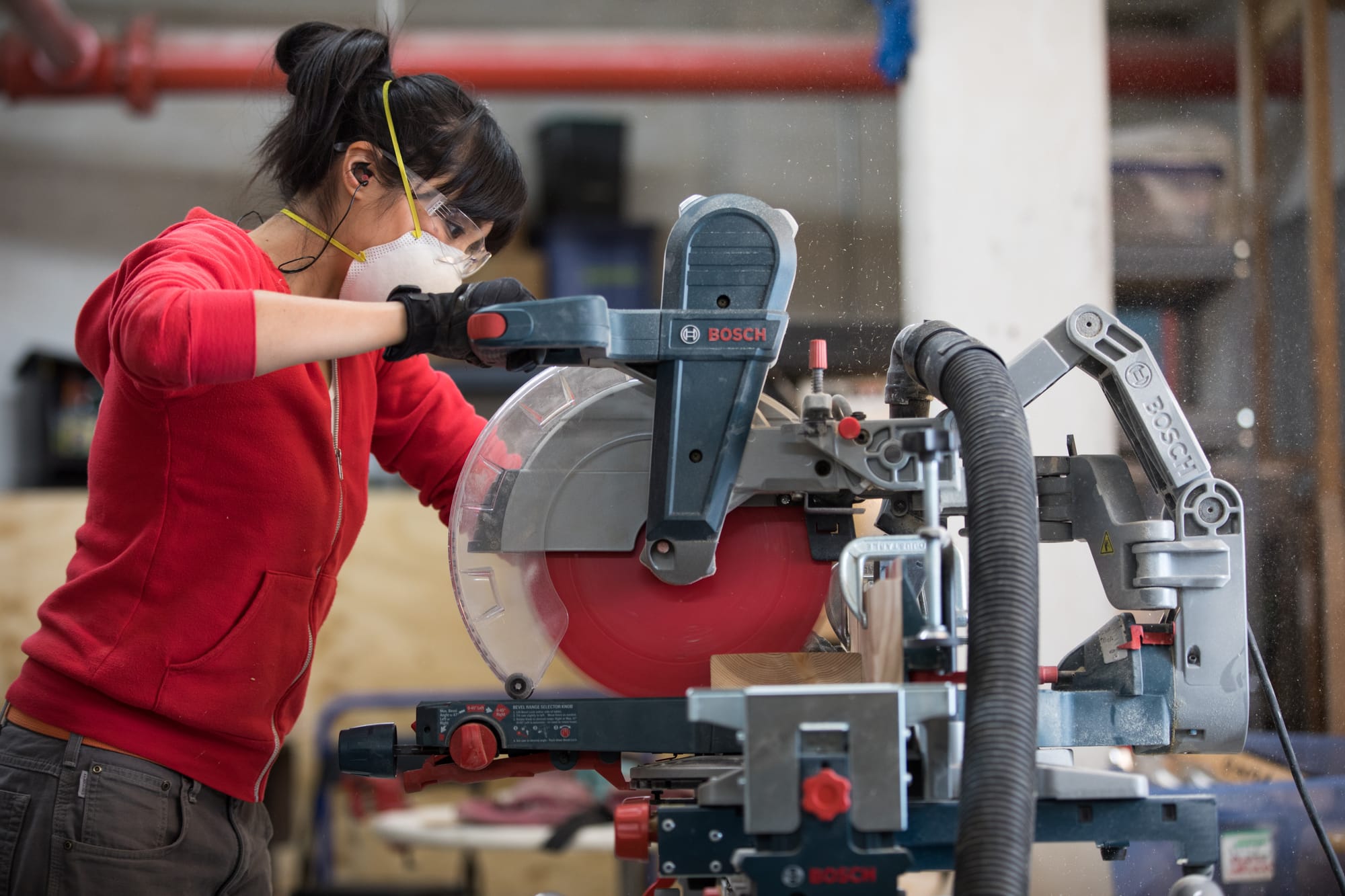
Jamin Warren: Do you have a cluttered place? Is your home full of objects as well, or is it the exact opposite—very austere?
Risa Puno: No, my partner would prefer if I had fewer objects. I fight hoarder tendencies, but actually, both digital and analog hoarder tendencies. But I try to do well with labels. My family heirloom is my grandfather's label maker. So I do well when I keep things organized. But yes, I do like to keep objects.
Jamin Warren: Nothing that a good spreadsheet can't solve for you.
So let's talk about games. One of the things that's been interesting to me about your work is that you're often recontextualizing some of the things that might be familiar to the public and you as a designer. You shared with me one of the early pieces that you did, which was Good Faith and Fair Dealing, an interactive maze game from 2012—one of your earliest projects. Can you tell me a little about what it is about games, particularly these types of public play that people are familiar with, and that is appealing to you as a creator, as someone creating those types of spaces for players?
Risa Puno: This project was part of the Volunteer Lawyers for the Arts art and law residency program. But I love games because they create a point of access for people. But I also really like how they can operate as metaphors for larger social systems. And they really can encapsulate human relationships between people.
So this project is a larger version of the classic game Labyrinth, where you're trying to get your ball through the maze without it falling into holes, but this version is two-player, and you're on the same tilting surface and have identical mazes. You have to choose whether to cooperate and get your balls through the maze or compete and focus on your individual goals. "... The title Good Faith and Fair Dealing is inspired by contract law because, for me, when negotiating a contract, you have a shared goal. After all, you're trying to get this deal done together. But when trying to execute the details, you'll often end up in different places, so you have to negotiate that.
And so when I built it, I used two different paint brands for the two identical mazes, so they would have different coefficients of friction and the balls would inevitably end up in different places to force that negotiation. Because I'm an asshole, but also because I wanted people to have to think about that, and have to think about what happens when we're in different places.
This project was also interesting for me as a learning experience, because when I first designed it, the handles went into the base of the machine, like bicycle handles. And so with the original version, the control mechanism wasn't as obvious and people were often fighting for control, and they ended up literally shearing the heads off screws.
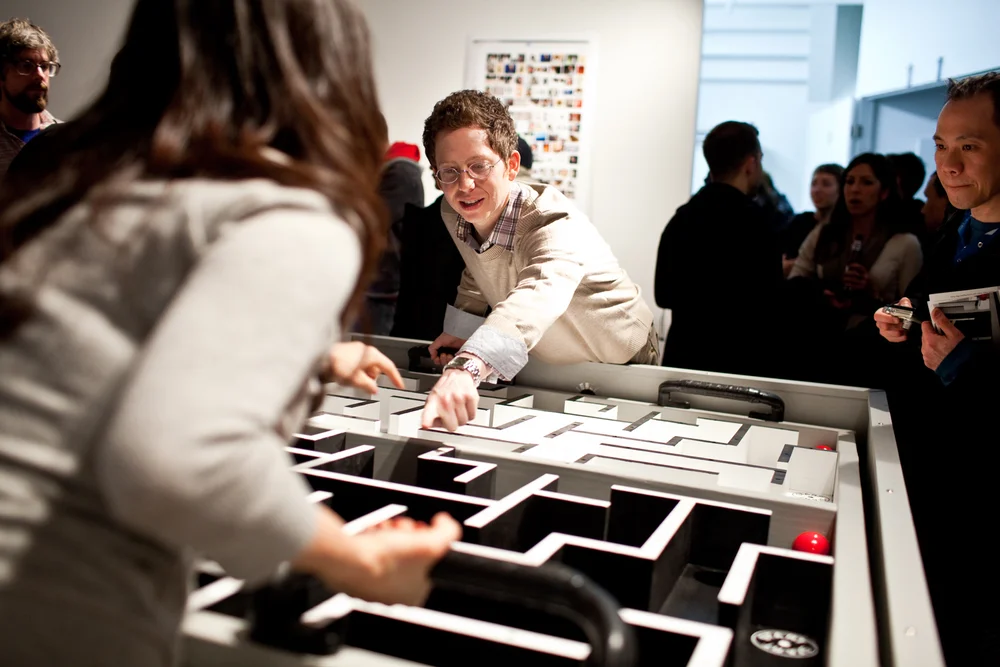
But after that, I moved the handles to the top of the maze, and people intuitively understood that they're both controlling the same tilting surface. Suddenly, they could see that the power structure is shared, and the project became a litmus test for people's relationships. For example, coworkers were excellent because they're used to negotiating, whereas romantic couples and new couples would be like, Oh, well, do you want to go here? Or, maybe we could do this, you know. And old married couples like my parents—my mom would be like, Okay, let's go here and let's go here and let's go here. And my dad would be like, Uh huh, uh huh, and just do whatever he wants, because that's their relationship. I even saw two identical twins get their balls through the maze without saying a word!
And so it's a game, but it's about relationships. And that's what I love about games—they can bring out so much about human nature because it's just a way for people to engage with each other. And whether you look at it, I sometimes see games as challenges we willingly take on. I sometimes look at them as a sort of set of rules of engagement with other people, sort of like a mini social contract. And so, however you want to look at it, or even just a safe space.

Jamin: Games, designed by humans, reflect the qualities and tendencies of the people who make them and their dynamic systems, both for players and designers. Both parties bring their expectations for what they would like players to do, and for players, what they expect out of a particular experience.
One of the things I like about your work is that you're recontextualizing some deeply familiar things and cutting through. There's this perception sometimes with party games as somehow being less complex than these deep systems, like really complicated card games with crunchy mechanics and a really big booklet. There's this idea that the complexity of instructions is a shortcut to the complexity of emotions. But there's no guarantee. Sometimes simplicity is a wonderful way to get people to engage with bigger and deeper ideas.
But I want to talk about The Course of Emotions, a mini golf experience you designed in 2013. Can you tell me a little bit about maybe the progression from what you learned from this work as a designer?
Risa: The Course of Emotions was a nine-hole miniature golf course where each hole presented an emotional obstacle to overcome. One hole was a worry, so it's a windmill, and the blades of the windmill are shaped like question marks because when I'm worried, my questions get in the way.
Worry leads to Frustration, a par-40 maze that spells "frustration." But honestly, I never got it in under 72, so frustration trips me up more than your average person. But that's the thing—how people dealt with this would often show how well they dealt with frustration, the actual emotion. Some people would look at this and be like, Oh, hell no, and just skip it. Some people would try to putt over it, even though it's not a driver, it's not a wedge—it's a rubberized putter. That's against the rules, but they would try to break them to get around frustration.
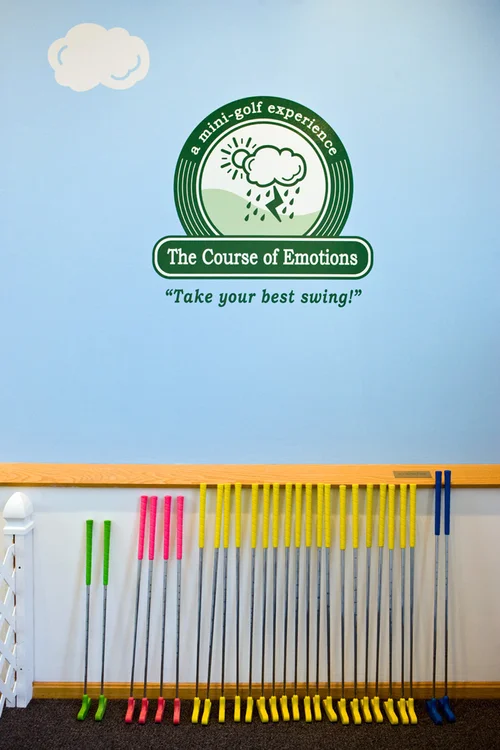
It's really interesting how people factor that in. I also saw that with the other project, what happens when people are met with these structures, because games are structures. How can you craft an emotional arc for people? This game had an arc, a mini arc within each hole, and an overall arc between all nine holes.
Jamin Warren: You ask people to step into spaces and maybe engage with complex emotions during play. With Good Faith and Dealing, those types of cooperative games invariably lead to frustration between two people in their relationship. The game serves as a locus for them to engage with that. You're cutting away, that someone might be in their daily life, and they're stepping into a play space and engaging with a par-72 golf course.
For you as a designer, how do you design things? How do you engage with your players to engage with those types of emotions? You're asking people to experience the thing as you're hoping to experience it, and be vulnerable at some step. You could make them very mad, as some game designers do, but you're asking people to ask broader questions.
Risa Puno: I try to do it through the lens of care. I think there's room for improvement in my practice, and there's a lot that I'm still learning. But what I've learned so far is about expectation setting. By borrowing from existing formats—for example, with mini golf—a certain amount of frustration and confusion is already expected in mini golf. They're literally called obstacles. Listing the par as infinity tells people, I am not expecting you to do this if you don't want to, right?

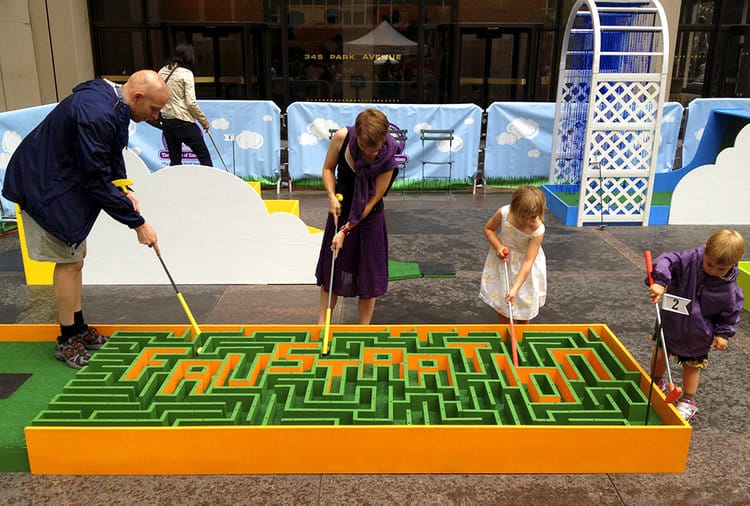
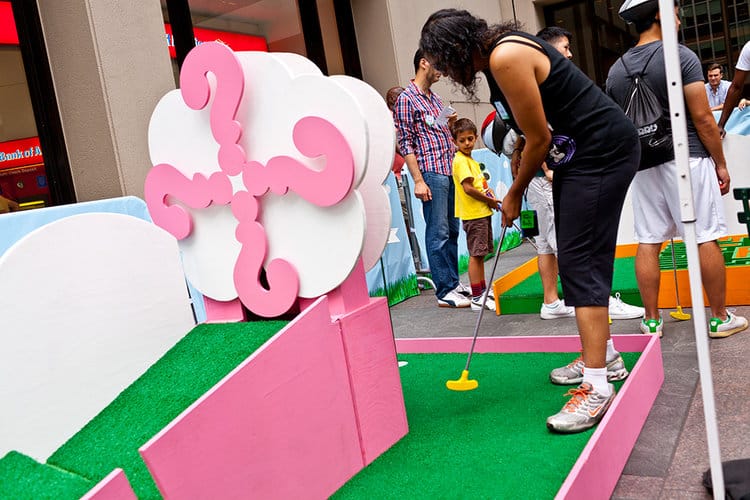
From top left: Despair, Frustration, Worry Photos: Megan Martin
One of those magazine scores on the scorecard says what you are—solid as a rock, on the brink, total basket case—because it was meant to give it that cheeky sort of Cosmo quiz vibe. I don't know if that's still a magazine, but that was its vibe, right? To give it that, to make it feel a little lighthearted, right?
On top of it is the last hole—all of them are negative emotions. It was worry, frustration leads to insecurity, insecurity leads to jealousy, jealousy leads to all these things—depression, despair, boredom, anxiety—but the last hole that I left them with was relief. At the very least, it'd be relief that this course is over, and that was where I wanted to give them that soft landing. The tee was right next to the hole and was a par one.
So part of it is thinking about—it's not just the soft landing, as in giving them an easy win at the end, it's making sure that after putting them through all of this, they understand what they're supposed to take away from the experience. If you leave it way too open-ended after putting me through a lot of emotional turmoil, then it just feels too unresolved.
Jamin Warren: It does seem as well that you're building a reputation through your oeuvre, which is a reputation. When we walk into an experience of yours, you will both be confronted with something that might be familiar in some shape or context. You are exploring these larger questions around the interiority of human existence, or asking people to think about engaging with their emotions explicitly through games in a much more direct way.
Whereas oftentimes games will have people engage with particular types of emotions, but negotiated through the veil of a fantasy experience, you kind of strip some of that away. There is no metaphor. We're just going to talk explicitly about what this game system I've designed wants you to do and feel.
Can you tell me about the Unresolved Rage Game for folks unfamiliar with that particular project?
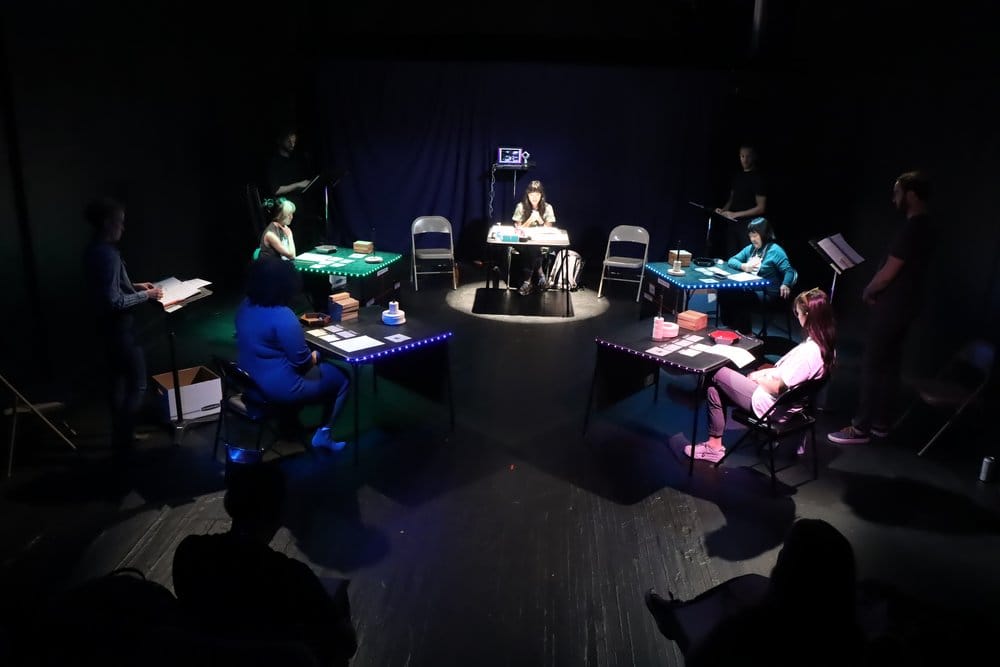
Risa Puno: Unresolved Rage started in 2022-2023. Originally, it was something I developed with Ran Xia as part of Soho Repertory Theater's Writer Director Lab. We developed the original concept as this immersive theater piece based on tabletop role-playing game mechanics—basically Dungeons and Dragons. Instead of medieval monsters, they were modern microaggressions. It was intended to be something about Asian femme rage.
You had an actual playable experience—I designed game mechanics—but we had actors who were playing the NPCs, actors playing the live tutorials, and our system admins. The admins had the impossible job of representing the oppressive and limiting system while having to keep players safe within it. That's a tough role.
We had four people playing at a time, no audience. That was it. We wanted to keep it super intimate. It would be four Asian femmes playing through some brutal game mechanics that are intended to help them unpack and process their relationships with rage. What we realized from that experience was that it was helping people. So what I've decided to do now is develop it as a community healing tool. That's what I'm doing with this now.
Jamin Warren: Your decision to have this game not be for the public was that driven more by the constraints around developing something in a post-pandemic context, or more like, "I don't know how I feel about putting this in front of people in a random context. I want to control some of the parameters for who gets to experience this type of thing, who gets to play through something like this"?
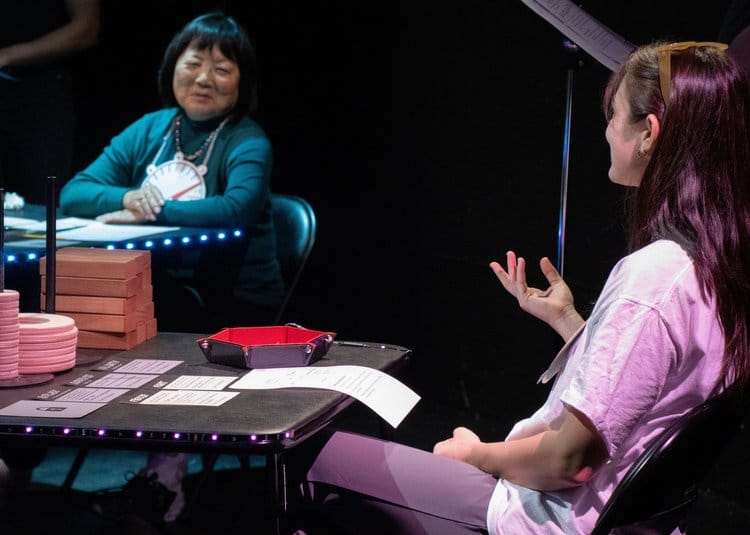


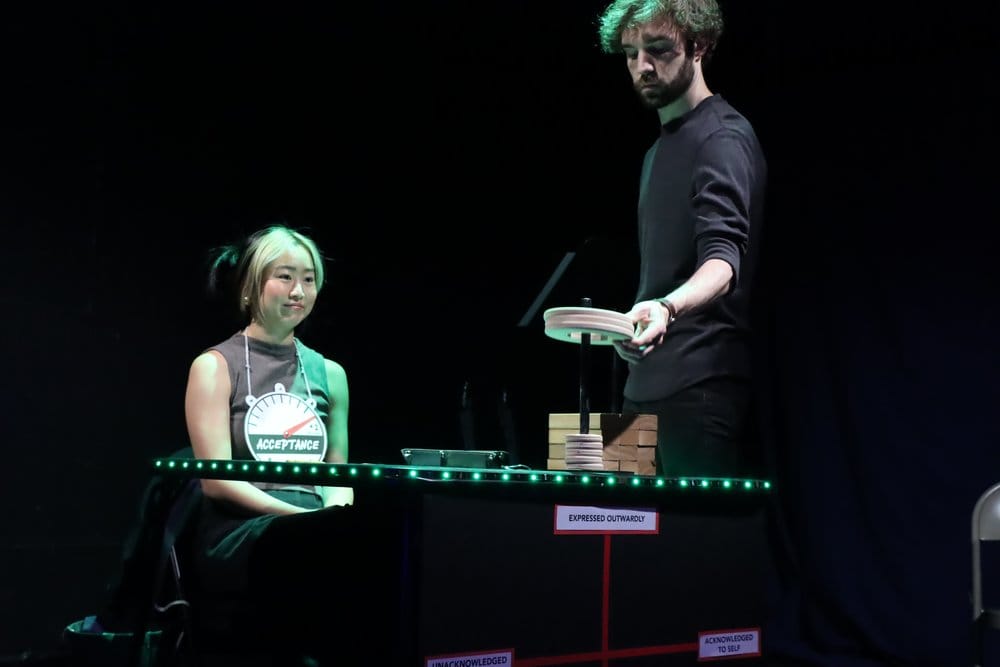
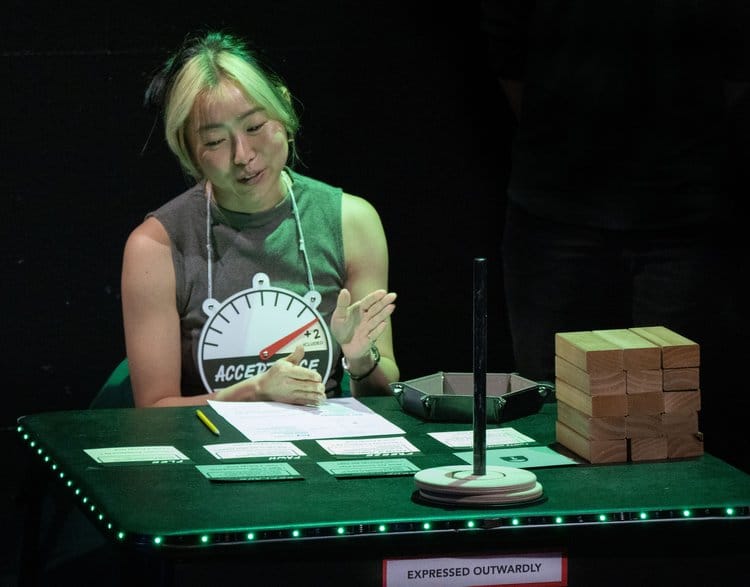
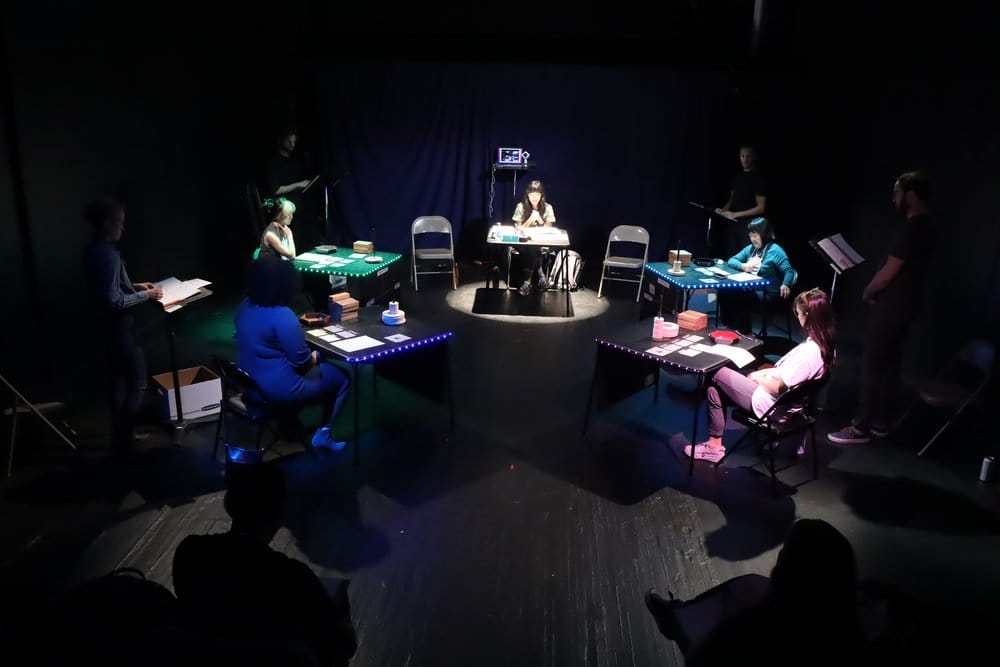
Risa Puno: Oh yeah, it was the latter. The other projects in the Lab were in front of audiences, and it would probably be much better in terms of funding and things like that if this were something designed to sell tickets to. But it's a pretty vulnerable experience that is specifically written for Asian women and femmes.
Basically, what happens in the game is that when your character's rage is triggered by a racist and/or sexist microaggression, you roll a four-sided die to determine how many degrees of incoming rage she has to process. First, you have your internal reaction, then your external reaction. For the internal reactions—if you deny your rage, you have to answer, "How do you convince yourself that you brought this on yourself?" It's super cringe, but the questions often bring out super honest answers.
And then your external reactions are based on trauma responses—freeze, flee, fawn, or fight. Fight in this game is asserting yourself, standing up for someone else, or confronting someone. It gets real super fast, and it feels really intimate. So I didn't want members of our community to have to do this in front of spectators. I didn't want them to feel tokenized or exploited, or like they were performing for others.
Jamin Warren: Yeah, it's like an observation bias, right? Having it be spectated would change the outcome in some way.
Risa Puno: Right. In fact, player were wearing a meter that tracks their acceptance in the eyes of the dominant group. You can be 'othered,' 'marginalized,' etc. So, having people watch you on top of that is a whole other layer.
We actually play-tested a version that was designed for an audience, but that was a whole other thing. That was a version we did—an allies version—where we had non-Asian and or non-femme people role-playing as us, and we had the audience cast as the dominant group. I was terrified. I was like, Am I gonna get canceled for this? But it worked out well. We switched around what the point of the game was. Rather than solidarity and support and sense of exhale, the goal of the 'allies version' was to get those players to have to do the emotional labor that we do every day. While roleplaying as Asian women and femmes, they had to spend energy advocating to allies, and then in the debriefing process, realize that they are the allies that we're advocating to. It was a tricky flipping the script and creating the cultural context necessary to pull it off, but the messaging came through surprisingly well.
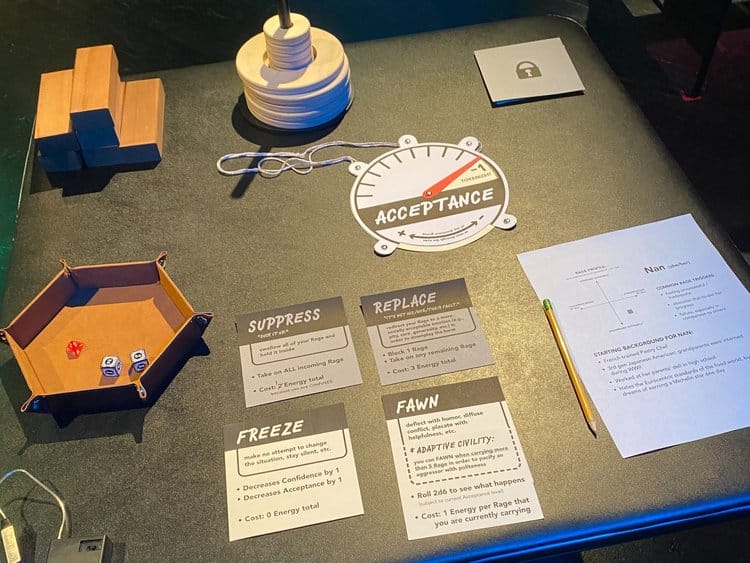
But I realized after running both versions back-to-back in the same day that the allies' version felt more like labor. Like emotional labor. Whereas running the original version just for Asian women and femmes felt more like play, even though we did the original version in the middle of the night after already running three hours of the allies' version earlier in the day. Which made me feel even more committed to making something for my community.
Because even during the pandemic, when it was like #StopAAPIHate, there were so many resources helping white people be better white people. When there were people who tried to attack me, and when I was going through that stuff, all I could find was bystander training. And I had such a hard time finding resources to help myself.
And so, I want this project to help our community.
Jamin Warren: We've discussed many of your projects, so let’s close with a Group Hug. Can you tell me about some of the conversations you were having creatively with yourself, going into Group Hug, and how that expressed itself through that particular project? I know the origin story you'll talk about. But from an artist standpoint, where you're starting to feel like there are certain questions that you may want to ask of your work coming out of your previous game-making experiences, that Group Hug may present an opportunity to do it differently?
Risa: Group Hug was my first museum solo show. And so for me, when I think of solo shows, I think of them as a chance to step inside the artist's brain, right? I had been making many public art and many things about community-based stuff. I said, okay, let's go super personal on this, which is scary. That was terrifying.
Jamin Warren: Yeah, that makes a lot of sense. You've been asking others to do this, so you must do it yourself. Can you tell me about the origin story for this particular work?
Risa Puno: Sure, yeah. What was going on in my personal life is honestly kind of crappy. I was thinking about self-care because I've been dealing with some health issues, but at the time, my dad got hit with a lot of health issues. My dad's somebody who has been taking care of people his whole life. He's an orthopedic spine surgeon—he's been doing this for three decades. He's got 90 U.S. and international patents. He's the inventor of the world's first polyaxial pedicle screw.
He got hit with some pretty serious medical issues, and all of a sudden, he's having to be taken care of instead of taking care of other people. My mom, a retired doctor, had to be in the caretaker role for him, and my brother and I had to help take care of her and my dad. Everyone in our family was reshuflling roles. Puno, my last name is the literal word for “tree” in Tagalog—and we're usually the branch of the family puno that has our stuff together. But suddenly, we’re drawing support from the other branches of the family puno."
It was a lot. It felt like a scramble. It felt full of anxiety. It felt very urgent. And for me, since I speak the language of games, if I had to put that in a game, it felt like whack-a-mole—just dealing with whatever pops up, not being able to plan.
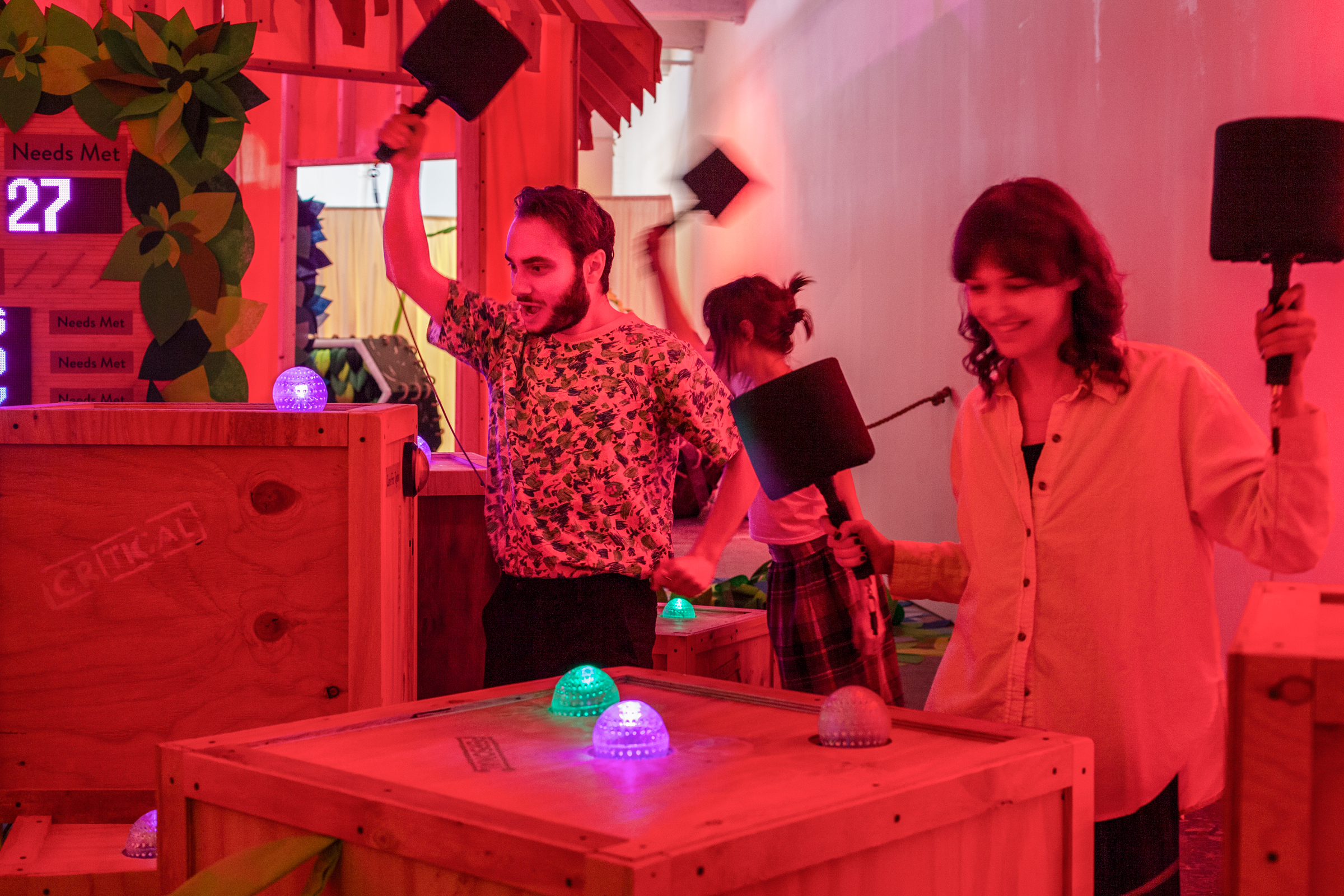
Jamin Warren: Guide me through the process of playing this particular game, and how it expresses your personal experience with your father and your family through the flow of the game itself.
Risa Puno: Sure. So the first thing you see when you walk in is two embroidered signs, because I learned to embroider. One says "cared for," and the other says "care for," so you have to choose. You choose whether you want to be cared for or care for that day. I loved talking to people about which path they would choose. Sometimes if would be the role that they are used to taking. Sometimes it would just be what they need that day.
If they choose "care for," they end up on the side with the multiperson whack-a-mole. There is a button that says "care for together" and all these boxes that say "critical," "urgent," "personal"—out of which pop up these spheres that light up, representing needs that need to be met. So you (and the people you are with) have to hit these needs, and they come up faster and faster and faster, just like the needs that pile up when caring for someone.
But on the other side of the experience, if you choose "cared for," you walk through this fabric labyrinth and end up in front of these geometric coconut pods with these leafy structures. If you have people who are willing and able to meet your needs, you stay reclined and listen to ocean sounds. But as soon as people get overwhelmed and can't meet your needs anymore, it comes out of chair form and gently stands you up on your feet. The center structure brings the two sides closer together to talk about their experiences. And when you pass through this space, you find yourself in a similar space, but flipped. If you initially chose "care for," you are now on a side with the pods and are to be cared for. And if you chose "cared for," you find yourself in front of a large multi-person whack-a-mole console. This is all about a precolonial Philippine ideology called kapwa, which is an underlying concept throughout my work, but especially this exhibition."
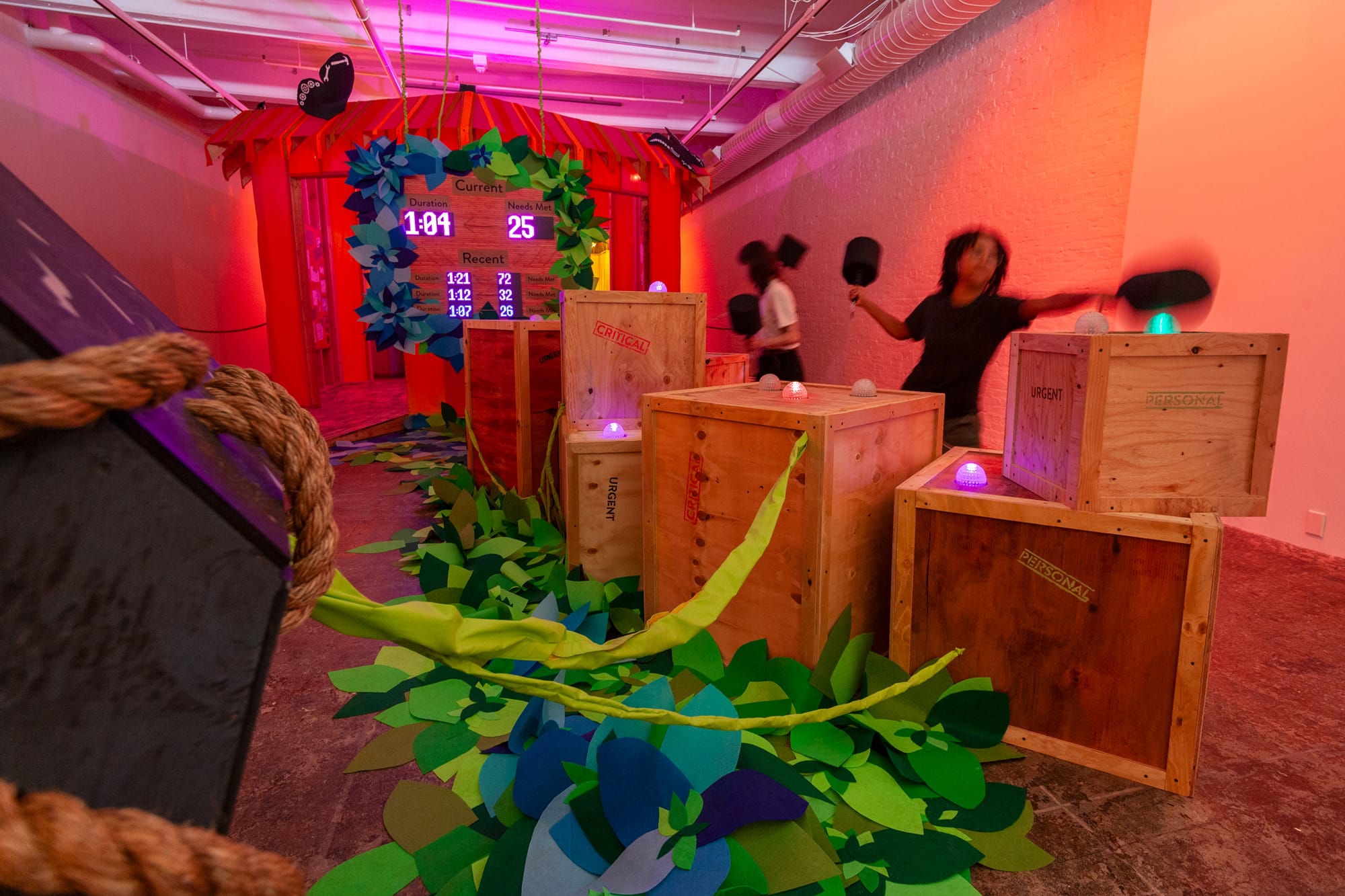
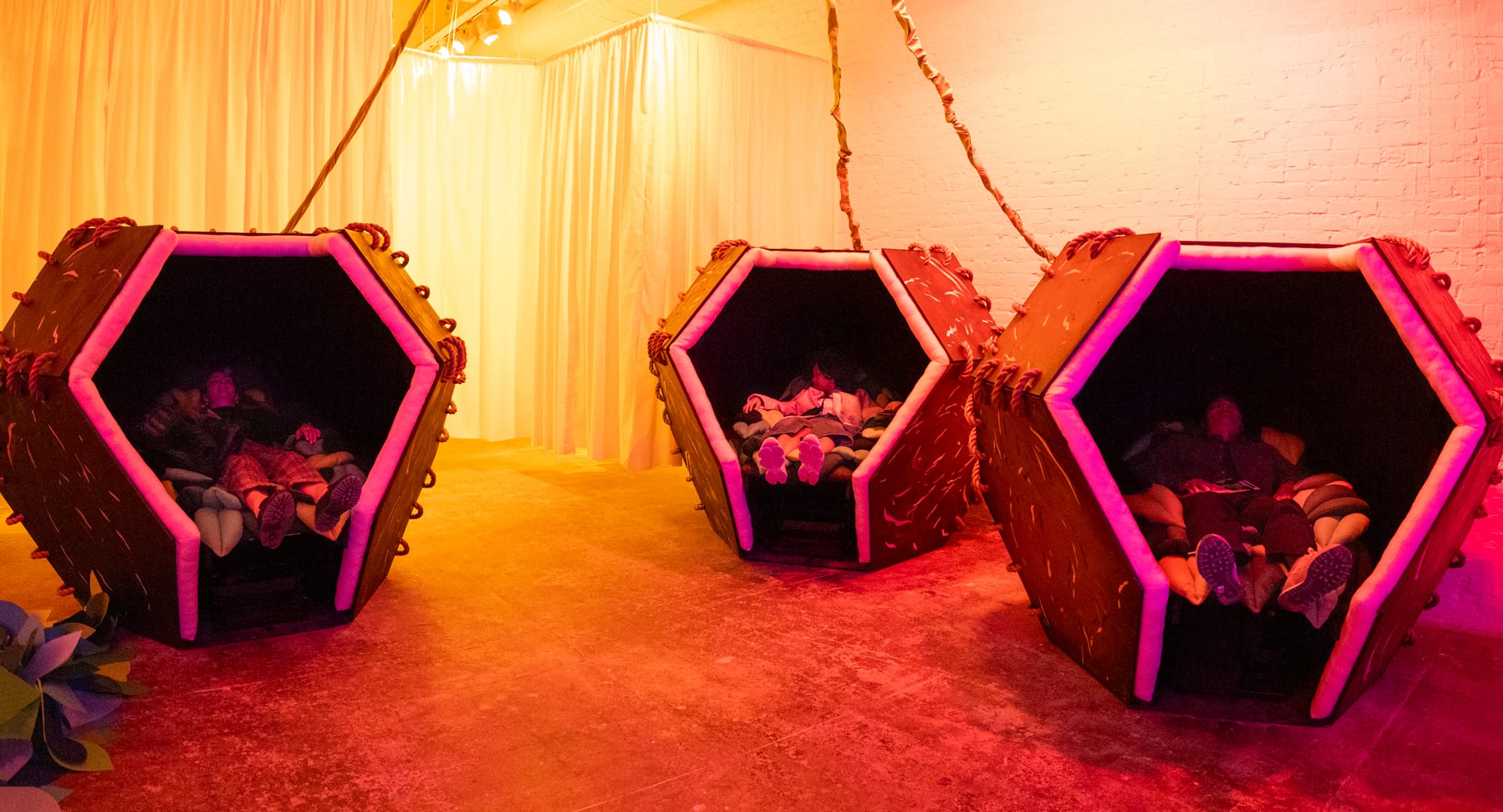
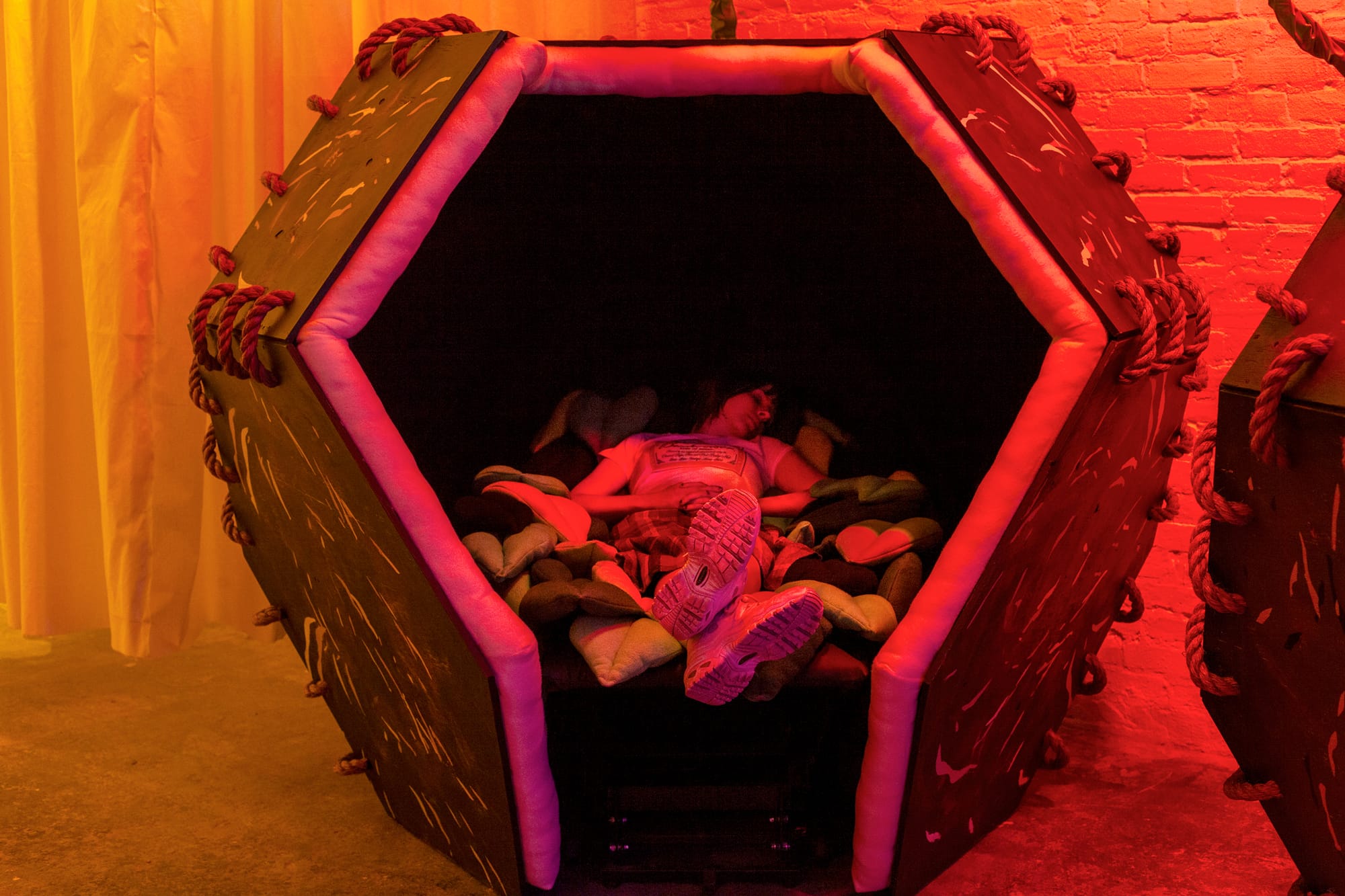

Photo: Carlos Avendaño
And kapwa means togetherness or shared humanity. It's this concept where we're essentially navigating life together, as part of a community, rather than alone. And it means that I have a moral imperative to care for you as I care for myself. And reciprocity is built into the exhibition's architecture. Also, the museum itself has entrances on both sides. And so I never wanted anybody to feel like they were coming into the back of the show. I wanted it to be symmetric. So there are those embroidered signs on both ends, so that no matter what, you're coming into the front of the show.
Jamin Warren: Got it. That's interesting. You're both trying to create symmetry, but also you're playing with asymmetric information, right? You wanted to create equal access for people to express themselves without ruining the experience. You can discuss what it was like to be cared for versus caring for others. So there's an opportunity for people to decompress in the middle of the experience.
Risa Puno: Yeah, and while I wanted them to make a choice, I didn't want to leave them feeling FOMO, right? I wanted them to feel like they had a complete sense of the thing. That way, they still had their agency but got to experience everything. Also, it speaks to that potential for an infinite loop of care if they just wanted to go out where the second set of embroidered signs were and just go right back in. They could keep looping all day if they wanted.
This interview was conducted as a talk for Gameplayarts in 2024. It was edited for clarity and grammar.


